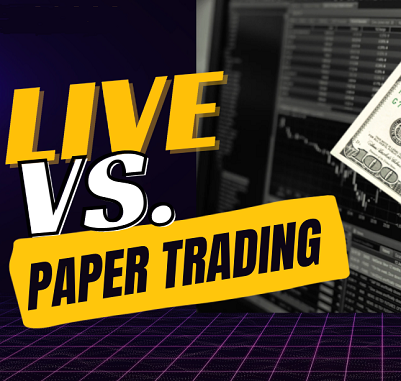
Both paper (demo) trading and real money trading offer valuable insights into the financial markets, but the two approaches have significant differences. Here’s a breakdown of the key distinctions between the two:
Emotional Impact
Paper Trading: Since no real money is at risk, emotions are minimal. Traders can make decisions without worrying about losing their hard-earned cash. This can lead to a more relaxed and less stressful trading experience.
Real Money Trading: Real money trading brings emotional pressure. The fear of losing real funds can cause stress, which may lead to impulsive decisions. Emotions like greed, fear, and overconfidence often cloud judgment in real-money trading.
Risk and Financial Consequences
Paper Trading: No real financial risk is involved. The money used is virtual, so the worst that can happen is losing the demo account balance, which doesn’t have any real-world consequences.
Real Money Trading: The primary difference here is the financial risk. Every decision has real-world consequences. If you lose money, it directly impacts your financial situation. This can lead to a heightened sense of caution and, sometimes, irrational decision-making.
Market Conditions
Paper Trading: Paper trading generally uses simulated market conditions that may not always reflect real-time volatility, slippage, or liquidity issues. Prices might not always move as expected in real-time, and execution can be immediate, even when market conditions are fast-paced.
Real Money Trading: In real trading, markets can behave unpredictably. Slippage, delays in execution, and sudden price movements can impact the trade outcome. These real-time market conditions provide more accurate practice and insight.
Execution and Order Types
Paper Trading: In demo trading, orders are typically executed instantly, and there is no concern about liquidity or partial fills. You may be able to buy or sell immediately at your desired price, even in volatile markets.
Real Money Trading: Real market orders might not always be filled as expected. Market conditions, such as liquidity shortages, high volatility, or large order sizes, can cause delays, slippage, or partial fills.
Strategy Development
Paper Trading: Paper trading is an excellent environment for developing and testing strategies. Since there is no real risk, traders can experiment with different methods to find what works best. It allows you to see the theoretical potential of a strategy without consequences.
Real Money Trading: While you can apply strategies in live trading, you will see the true impact of your choices. If a strategy doesn’t work, the financial consequences will be immediate, forcing you to adapt and refine your approach. Real money trading involves adjusting strategies to minimize losses and maximize profits based on actual market data.
Psychological Factors
Paper Trading: With no real financial risk, traders may take larger risks or make trades they wouldn’t normally consider in live markets. This may create a false sense of confidence, as the psychological pressure to succeed isn’t there.
Real Money Trading: The psychological pressure is a significant difference in live trading. Fear of losses can cause hesitation, and the desire for gains may lead to overconfidence or risky behavior. It’s harder to stay disciplined when real money is at stake.
Learning Experience
Paper Trading: Paper trading is an excellent educational tool. It’s ideal for beginners who want to learn the basics of trading, familiarize themselves with a platform, and test strategies without the risk. However, because it lacks real financial stakes, it doesn’t fully prepare you for the emotional aspects of real trading.
Real Money Trading: Real trading forces you to confront emotions, make decisions under pressure, and deal with losses and gains. It teaches you about risk management, emotional control, and market dynamics in a way paper trading cannot replicate. The experience gained from live trading is invaluable and is where true growth as a trader occurs.
Time Commitment
Paper Trading: As it involves no actual financial commitment, paper trading can be done at a leisurely pace without much stress. Traders can practice strategies and test theories without worrying about the time it takes to monitor positions.
Real Money Trading: Real trading demands more attention and commitment. With real money on the line, you must carefully monitor your positions and be ready to react quickly to market changes. Time management becomes critical in live trading to mitigate risk and manage your portfolio effectively.
Account Replenishment
Paper Trading: If your demo account balance runs out, you can easily replenish it with more virtual funds. This makes it easy to continue practicing and experimenting with different approaches.
Real Money Trading: If you lose money in real trading, it cannot be replenished easily. You must either deposit more funds into your trading account or adjust your strategy and risk management techniques to recover. This highlights the importance of proper risk management in live trading.
Data Accuracy
Paper Trading: The data in paper trading platforms may not always mirror real-world conditions, as it is often based on historical or delayed data. In some cases, the price movements might not reflect the real market’s behavior.
Real Money Trading: In live trading, the data is real-time, and prices move with the market. This means you’re operating under authentic conditions, which can lead to a more accurate understanding of market trends.
Conclusion
While paper trading provides an excellent risk-free environment to practice and learn, real money trading offers a much more authentic and challenging experience. The psychological impact, financial risk, and live market conditions involved in real trading can significantly differ from the simulated experience. Both are valuable, but real money trading is where you truly develop as a trader, learning to manage emotions, execute strategies under pressure, and deal with the financial consequences of your decisions.
